- News
- Reviews
- Bikes
- Accessories
- Accessories - misc
- Computer mounts
- Bags
- Bar ends
- Bike bags & cases
- Bottle cages
- Bottles
- Cameras
- Car racks
- Child seats
- Computers
- Glasses
- GPS units
- Helmets
- Lights - front
- Lights - rear
- Lights - sets
- Locks
- Mirrors
- Mudguards
- Racks
- Pumps & CO2 inflators
- Puncture kits
- Reflectives
- Smart watches
- Stands and racks
- Trailers
- Clothing
- Components
- Bar tape & grips
- Bottom brackets
- Brake & gear cables
- Brake & STI levers
- Brake pads & spares
- Brakes
- Cassettes & freewheels
- Chains
- Chainsets & chainrings
- Derailleurs - front
- Derailleurs - rear
- Forks
- Gear levers & shifters
- Groupsets
- Handlebars & extensions
- Headsets
- Hubs
- Inner tubes
- Pedals
- Quick releases & skewers
- Saddles
- Seatposts
- Stems
- Wheels
- Tyres
- Health, fitness and nutrition
- Tools and workshop
- Miscellaneous
- Tubeless valves
- Buyers Guides
- Features
- Forum
- Recommends
- Podcast
review
£5,815.00
VERDICT:
The Eos can work well as a conventional tandem, but comes into its own as an unconventional one
Extreme range of size adjustment
Wide variety of customisation options
Ability to be transported safely
Taking advantage of all that flexibility comes at a price
Weight:
21,000g
Contact:
At road.cc every product is thoroughly tested for as long as it takes to get a proper insight into how well it works. Our reviewers are experienced cyclists that we trust to be objective. While we strive to ensure that opinions expressed are backed up by facts, reviews are by their nature an informed opinion, not a definitive verdict. We don't intentionally try to break anything (except locks) but we do try to look for weak points in any design. The overall score is not just an average of the other scores: it reflects both a product's function and value – with value determined by how a product compares with items of similar spec, quality, and price.
What the road.cc scores meanGood scores are more common than bad, because fortunately good products are more common than bad.
- Exceptional
- Excellent
- Very Good
- Good
- Quite good
- Average
- Not so good
- Poor
- Bad
- Appalling
The Circe Eos must be one of the most multi-functional tandems available, without any compromise on outright performance: with the appropriate specification it can perform like a 'normal' tandem, yet it offers a wide range of size adjustment and has a better ability than most to be broken down for travel.
Anyone considering a tandem is already looking at a niche part of the market; if you want it to be suitable for an unusually wide range of sizes then you are in even more of a minority – and one that can be taken apart and stuffed in a suitcase for transport is even more specialist. The Circe Eos can tick all of those boxes if required.
Circe Cycles will be known to many of you as the producer of the Helios tandem, a small-wheeled machine that prioritises portability, versatility and adjustment over outright performance. With the Eos, Circe has kept much of what made the Helios popular, but improved the specification and made it a bit more mainstream.
Models
There are two standard specifications, both based on the same one-size-fits-all (and does-it-all) frame: the sportier model (called Sport) offers drop bars, derailleur gears, and 26in (559) wheels; the touring-orientated model (called Tour) offers flat bars, internal hub gears (IHG) from Rohloff, and 24in wheels with fatter tyres.
I chose the Tour model as the basis for this test, but you can also go à la carte to get something that suits your needs exactly. Flat bars with derailleur gears would be easy to achieve; drop bars with IHG would be harder, but various aftermarket adapters are available to help.
As with the Joey from sister company Airnimal, you can take advantage of the interchangeability of fat 24in and thin 26in wheels to have a second set, so that you can change the nature of the bike; the Eos uses the same wheel sizes, so the same opportunities are available.
Frame and fork
The frame is made from 7005-series heat-treated plain-gauge aluminium with some seriously oversize tubes. The same frame is used for both derailleur and hub-gear models, so is festooned with all the fittings and cable guides required for both, including a front derailleur mount.
There are even brake bosses on the rear for cantilever or V-brakes – but they are only usable with the 24in wheel size.
The unusual frame shape limits where bottle cages can be mounted, so as with the Helios, two of them are on the top tubes, where they tend to get in the way if you use the 'step through' method to climb aboard. A third mount is placed more conventionally on the front down tube.
I couldn't fault the quality of the frame or its paint finish, nor the quality of assembly. If it were my own bike I would shorten a few cables – although most of the 'surplus' is necessary if you want to take full advantage of the size adjustments possible.
The Eos introduces an all-carbon fork with what must be a unique specification: tandem-rated, tapered steerer, disc brake, thru-axle, mudguard and rack fittings – and compatibility with 24 and 26in wheels!
The Eos goes to the extra cost of using an eccentric bottom bracket to take up chain (or belt) slack, rather than the less elegant chain tensioner used on the Helios. The rear triangle also has the split necessary to allow for the fitting of a belt drive.
Components
Let's go through some of the standard specification.
The 24in wheels on the Tour use 36 Sapim Strong butted spokes, which step up from a regular 14g (2mm) to a meatier 13g (2.3mm) for the bend; when combined with the smaller wheel size it all makes for a reassuringly sturdy package.
As standard they are shod with 24 x 1.75in (47-507) Marathon tyres from Schwalbe, which have a reputation for being durable and rugged, and are deservedly the first choice of many. However, some of that robustness undoubtedly comes from a fairly hard rubber compound, which might be why we occasionally suffered from wheelslip when riding hills out of the saddle on damp roads – I doubt that it was our awesome power output to blame. The price of that long life is also reflected in the weight of each tyre: 860g.
Both issues were solved for me with a (no-cost) change to another tyre, again from Schwalbe: the Kojak. At 24 x 1.5in (40-507) these are narrower, but more importantly at 380g each they are lighter, and seem to use a softer compound. That's a weight saving of nearly 1kg from a tyre change alone! You notice that.
The Kojaks suited my current riding conditions better, but the Marathons would have their place in other circumstances. Indeed, I would put them back on for the winter months when puncture resistance was the priority. I am reassured to see that even with a relatively unusual wheel size such options are available.
The Circe-branded cranks are forged and nicely finished, and are mounted onto old-school square taper bottom brackets: it's proven technology that is easily serviceable – and still works. I wouldn't be keen to trade that for any promised increase in stiffness from one of the newer 'standards', and the reduced choice that they bring.
The bolt circle diameter (BCD) is 130mm for the outer rings (meaning a minimum size of 39 teeth), with a 74mm BCD for the inner ring when used as a triple (so down to 24 teeth). It's used 'in-line', so the whole drive is on the right-hand side and no tandem-specific pedal threads are required.
Crank lengths are a personal preference, and there are several to choose from – although the published specification does not make that clear. We chose 170mm and 165mm, to help address the difference in our preferred natural cadence. There's even a 125mm kids' size – and if you want something really unusual, Circe can shorten cranks.
The Shimano MT-6000 Deore hydraulic disc brakes are dependable, and just work. Three-finger levers were used so that the blade on the right-hand lever could reach round the twist-grip gear shifter. The 180mm rotors provided as standard will suit most people, but other sizes are available. When it comes to replacement just be aware that the Rohloff IHG unhelpfully uses a unique four-bolt fitting 'standard'.
The specification isn't very specific about saddles, simply listing Ergon. Again, this is because you have a no-cost opportunity to choose what you want. The recommended Ergon SFC3 partial-gel saddle was acceptable for me, although I won't be getting one for my own use; on the other hand, my wife loved her Bioflex Gel Ozone so much that we will be getting one for our tandem.
I am not normally a fan of kickstands, but the Pletscher Twin Leg could convince me, and I was surprised by how often we used it. In action it supports like the centre stand of a motorbike, but folds away neatly to one side. It can also function as an impromptu workstand, but unfortunately its scope is restricted by the left-hand crank hitting it, thus preventing a full revolution. A slight change in position or shape could solve that.
Additions
Since the Eos is assembled in the UK, it can be customised as required, so I took the opportunity to add a few things.
Unfashionable they might be, but I wanted bar-ends, so the regular grips were replaced with Ergon GP3s for £22 extra. These combine Ergon's usual flat palm rest with an independently adjustable mid-length extension – and a Rohloff shifter-compatible length. No complaints about the comfort, and minimal impact on the packing process when travelling. The standard padded foam sleeve on the rear bar was a hit, and is something else that we will be adopting for our own machine.
Up next was a rear pannier rack, the Racktime Fold-it 24in for £45. The 24in designates shorter struts than normal, so that the rack sits close to the wheel and keeps the weight of any luggage as low as possible. The 'Fold-it' indicates that the rack bolts together. I normally prefer one-piece welded racks without any such potential points of weakness, but the ability to partially dismantle the rack made it possible to include it in the case for travelling.
Equally unfashionable in some quarters are the mudguards. These were proper bolt-on Chromoplastics from SKS for £36, although quick-release Raceblades are also available for £50. The front guard had a single set of stays; I would have preferred two sets of stays to reduce movement over rough surfaces. At the rear, I can't understand why the same bolts are used to mount the mudguard stays and rack when sufficient holes are available to provide separate attachments – with the extra security that brings.
Most manufacturers don't spend money on decent pedals, and fit the cheapest possible option in the knowledge that users will immediately fit their pedal of choice. Circe goes further and supplies no pedals at all, so effectively the initial price doesn't give you a rideable bike. There is a wide range of pedals on offer, mostly from Wellgo. I chose the WAM-M19/QRD-1 for £85/pair, a double-sided SPD-style pedal with a no-tool release facility.
With Wellgo's quick-release system, a 'docking station' screws into the crank, and the pedal itself can be quickly and easily removed without tools: it's a neat trick, and it's great to have for transport or storage. There is a bit of play in the interface, but you don't notice it in action. However, you may well notice the few millimetres increase in Q factor, the distance between the pedals.
Like many other manufacturers, Wellgo claims that its pedals are compatible with Shimano's SPD system and cleats. This is largely true, but I found that their performance with Shimano cleats was far more sensitive to wear than on a Shimano pedal. The more worn the cleats that I used, the less consistent was the ability to unclip – so I only felt safe using my least worn shoes. Of course, you could always use the Wellgo cleats provided, which should offer a better experience.
Rohloff hub
Our Eos used the Rohloff Speedhub 500/14 internal hub gear (IHG), which is included in the recommended specification for the Tour version. IHGs are different to a derailleur gear system – not necessarily better or worse, just different – and I think they suit the bike's intended use rather well, including being packed into a case.
With any IHG, I always appreciate the option to change gear when stationary, the simplicity of sequential gear selection, the ability to change through multiple gears in either direction, and the maintenance advantages of having everything enclosed. The extra strength of a dishless rear wheel is doubly welcome on a tandem.
Many of the previous disadvantages of IHGs have been largely overcome, with wide ranges, more even gear spacing, and the removal of any neutral gear all now readily available. However, the opportunity for on-the-road repairs are still limited – in the unlikely event of this being necessary.
The pinnacle of the IHG world at present is the Rohloff hub (although I suspect that Kindernay could provide serious competition). It offers 14 gears over a 526% range, with evenly spaced jumps. This range can be beaten by a few derailleur systems, but only at the expense of a valueless overlap of gears, and/or unacceptable jumps between them.
> Bike gears: find out why bikes have so many, and the surprising way they’re measured
The hub is an impressive piece of engineering, as it should be: it costs around £1,100. This accounts for about £700 of the price difference over the Shimano 105-equipped Sport model. To a greater degree than with any other IHG, you will notice the concentration of weight around the rear hub – although Rohloff claims that the overall heft is not significantly different to a complete derailleur system. Obviously, it all depends what you are comparing against.
As standard, the gear range supplied is 21in to 111in: I know that I always regret the absence of a lower gear more than a higher gear, so I asked for the lowest gearing possible. This turned out to be 19in to 100in. You can choose other gearing options to suit your needs, without any cost implication. Although tandem use is sanctioned by Rohloff, to maintain your warranty the minimum chainring:sprocket ratio rises from the 1.9:1 for solo use to 2.5:1.
> How to get ultra-low gearing on your bike
Don't tell anyone, but if it were my machine I would be tempted to ignore any restrictions on gearing after the two-year warranty period – or even earlier. Neither of us is particularly powerful, and this hub really does feel capable of handling our maximum output without complaint.
In use, it won't be long before you notice one of the more contentious issues surrounding Rohloff: of all the IHGs that I have used, none come close to making the same level of noise.
A quick bit of explanation is in order: within a Rohloff, the top seven gears are like using a 7-speed cassette in the big ring; the lower seven gears use the same cogs on the equivalent of the small chainring. The problem is that the 'small chainring effect' is achieved through some ratio reduction gearing, which is the primary cause of the noise.
Whereas gears 8 to 14 make a noise comparable to a slightly dry chain, gears 1 to 7 introduce noises not unlike an electric motor, with additional hints of 'knobbly tyre on tarmac'; this varies by gear, and by power input. You probably wouldn't be aware of it if there are other noises such as traffic, wind, or wet roads, but it would certainly be noticeable when winching up a quiet climb.
I am assured that the noise normally quietens down after a few thousand miles. If you think it will be an issue for you, I recommend that you try a fully run-in hub for yourself so that you know what you are letting yourself in for, and balance that against the undoubted advantages of the system – and choose derailleur gearing if it's not for you.
Gates belt drive
A belt drive system is also an option, and again is included in the recommended specification of the Tour version. It is only possible with a single-sprocket system (such as an IHG), and this was a good opportunity to try it out.
The Eos uses the premium Gates Carbon Drive system, CDX, which is claimed to operate within an impressive temperature range of -53°C up to +85°C – which is far beyond my own limits! However, the standard version is not approved for tandem use; since only the rear drive has to cope with the power of both riders, a heavier duty EXP belt is used there – which increases the pitch from 8mm to a chunky 11mm.
There are a few hurdles to overcome to make a frame 'belt drive-ready', including the ability to split the rear triangle, perfect alignment, and (ideally) a frame that is sufficiently stiff to be approved by Gates.
You will immediately notice the lack of any noise in use (which makes Rohloff's contribution all the more noticeable). When the time comes, you will also appreciate the ease of maintenance in virtually all conditions, where a simple wash with water will normally suffice, along with the occasional squirt of silicone spray.
In use, it is important to maintain the correct belt tension: too tight, and it leads to premature wear; too loose, and it can 'ratchet'. Naturally there is a proper workshop tool, but for consumer use 'there's an app for that'. Yes really, there is: you twang the belt like a guitar string, the Carbon Drive app measures the frequency, and you check that it is within the approved range.
I had some concerns about the system before using it: surely it would feel a bit 'soft' compared to a chain? No, just smoother, and less 'mechanical'. Would it be as efficient as a perfect chain? Probably, except perhaps in some exceptional circumstances, but I doubt that users would notice any difference in real life.
To be on the safe side, Gates requires the use of a 'snubber' for the final drive sprocket, which is a little roller that operates a bit like a chain catcher. We had no problems, even when putting out maximum power, out of the saddle, on the steepest of hills.
There is a minor weight saving over a chain drive, but there is also a high price to be paid: it accounts for a substantial £506 of the difference from a chain-driven model, although remember that includes the three chainrings (belt-rings?) as well. However, reports suggest that by the time you have to replace a belt drive system, you would have got through several chains, cogs and even chainrings, so in the long-term the cost difference won't be so great.
When the time does come for replacement, don't expect to find lots of alternative aftermarket brands offering lower pricing or better availability – and be aware that belts from Gates only come in a few pre-determined lengths, so you will always be limited in your gearing options.
The instructions emphasise that a belt can be prone to damage if abused; while it seems to be plenty tough enough in normal use, I was always conscious of its relative fragility compared to a chain. For transport, the drive belt remains in the rear triangle, and the timing belt loops nicely round a wheel – so both can travel with reasonable protection.
If you don't want belt drive, you can choose chain drive from new – or indeed at any point in the future. It is not an irrevocable decision, just a costly one.
Adjustability and fit
There is far more height adjustability on offer here than with any conventional tandem, so that the one frame available really can fit most people.
The maximum height achievable for the 'centre of BB to top of saddle' measurement is frankly in clown bike territory: 92cm at the front, and 96cm at the rear. That's very high.
As for the minimums, you could get down to 56cm at the front (allowing 6cm for the stoker's stem clamp), but it would require about 9cm to be cut off the end of the seatpost. The rear could drop to 42cm.
For those familiar with the Helios, the minimum saddle height is 2cm more at the front and 6cm more at the back, so the Eos isn't quite as friendly to small people.
Just as important is the reach, with stokers often suffering from a cramped cockpit. By increasing the maximum reach on the back by 6cm over the Helios, Circe has matched more conventional machines and made the rear more comfortable for larger riders.
Reach has also increased at the front by 2cm over the Helios: it still took a 150mm stem for me to achieve my perfect position with straight bars, but then I do like a rather long reach.
All this adjustment is achieved with numerous quick-release clamps – you really do have to know how to operate a QR properly with this bike!
For starters there is the standard single QR on the front seatpost, and then the two on the telescoping rear post; incorrect operation here might only result in the wrong saddle height, or perhaps a few elusive creaks. Far more important is the QR used to attach the fork steerer onto its extender – to which are mounted the bar and stem. It's very convenient (and an impressive thing to demonstrate to others), but it is probably the most safety critical QR lever you will ever encounter.
Although the extender is fitted as standard, you could save £70 and leave the standard steerer. In doing so you would reduce the range of height adjustment available, and make removal for transport a bit slower. The QR facility also allows you to pivot the bars without tools, to make the machine narrower for storage.
Incidentally, I had a lot of surplus extender sticking up above my stem. If it were my own bike I would be removing most of it, but it does illustrate that the handlebar could be set very high if necessary.
It's rare to combine an IHG with a QR clamp, but Rohloff has managed it here. It saves a bit of time, but doesn't really save a tool because you still need something for the thru-axle on the Hope front hub. Alternatively, with a change of rear dropouts, you could change to the thru-axle version of the Rohloff hub.
Separation
One advantage that the Eos can have over more conventional tandems is the ability to reduce its size considerably for transport or storage – as long as you pay an extra £575 for the separable system. This allows you to completely remove the two tubes connecting the front and rear triangles.
It would be easy to reduce this cost by only having only one coupling per tube, by simply splitting the frame down the middle; however, this would not be as successful in reducing the size of the finished package. What's more, you would be left with fairly long lengths of unsupported frame tube that would only be attached at one end, and could be vulnerable to damage.
As an added bonus of the system, you can insert a 'triplet kit' – which could also function as a 'social-distancing kit' if there were only the two of you!
Rebuilding is a remarkably easy task to perform, thanks in part to Circe's use of two different attachment methods. In Circe's words: 'The design, using a compression drain pipe and coupled rear top tube, makes for easy re-coupling, the drain pipe effectively holding the two ends of the tandem in place ready for the insertion of, and final alignment with, the coupled top tube.'
What this means is that you only have to fit one tube at a time: I liken it to hanging a removable gate or door, where it can be very difficult to hold everything steady while you try to line up both hinges together – whereas the trick is to have one prong longer than the other, so that you can concentrate on one thing at a time.
> The no-fly guide to taking your bike on holiday…
In use, I couldn't tell that it was a separable frame: if all eight bolts have been tightened up properly, there is no movement or noise.
Apart from the added cost, the only disadvantage is the increase in weight: the net increase of 812g is the result of taking out 324g of frame material and inserting 1,136g of couplings.
There may be a remote chance that the bike could be more easily stolen if you don't take the separability into account when locking the bike, as thieves could potentially remove a frame tube if they knew what they were doing – no special tool is required, as the entire job can be done with a 6mm hex key.
It didn't seem possible that the complete machine could fit into one of Circe's £299 Traveller cases, as not only is it little bigger than the case that I use for my Airnimal Chameleon, it is smaller than most regular bike boxes.
However, it soon becomes apparent that once you have removed those two connecting tubes, what's left is no bigger than a solo machine – and the use of slightly-smaller-than-standard wheels helps to minimise the overall dimensions.
You might be surprised at what can be left on (or has to be taken off) for packing: just be warned that it is not a quick job – and neither is the reassembly task at the other end. It is well within the abilities of anyone with moderate mechanical skills, but it is not a job to be hurried if you want it to all fit in, then arrive without damage, and still be safe to ride afterwards.
> Buyer’s Guide: 17 of the best bike bags and boxes
Both seatposts have a scale marked on them to aid correct positioning during reassembly; I would have liked to see that on the front extend further up so that it could do the same job for the stoker's stem as well.
Although only the right-hand front crank has to come off, I feel that self-extracting fittings would have been useful – even if only on that crank – as this would reduce the tools required when travelling.
I did notice that the hydraulic brake hose to the rear calliper could be vulnerable to contact with the travel case. The folk at Circe tell me that they plan a change so that the hose leaves the calliper at 90 degrees, which could also improve the aesthetics of the routing.
Our complete bike in a single case weighed 31.5kg; that is above the baggage limit for many economy flights, so if that is a problem then either use two smaller cases – or travel in business class and benefit from a more generous allowance!
Our bike alone was 21kg, but that is for a fully featured machine, and is almost as heavy as you can make it. You could easily save a few kilograms with a different specification.
I had planned to make more use of this aspect of the Eos, but as we now know there has rarely been a worse time to be visiting other countries, let alone flying anywhere, so I had to settle for the odd car-assisted trip (which didn't require much disassembly).
Ride and handling
And so to the all-important question: how does it ride? If I can descend at over 50mph, and – separately – take all four hands off the bars, then I am confident that the handling holds no surprises – and that was the case here.
The steering errs on the side of stability more than agility, which is appropriate for the intended use; it will be especially beneficial when loaded.
Note that the steering's trail will vary by a few millimetres when changing between wheel sizes, depending on the size of tyre, so expect to feel a small change if you are swapping wheels.
We were quite happy operating round the narrow lanes in the Chilterns, dodging hazards and attacking hills. We also took advantage of the lower traffic volumes during lockdown to venture onto bigger roads that are normally too busy to be desirable, and offered other challenges: faster descents, sweeping bends, different surfaces – and the Eos could handle it all with aplomb.
We prefer to tackle short hills out of the saddle, and the Eos allowed us to do that without difficulty – as long as we were co-ordinated, of course. As with any tandem, keeping control of a machine with two independent bodies on board is normally the biggest challenge, and in that the Eos did everything that we needed of it.
A frame with large diameter aluminium tubes is ideal for providing enough stiffness for something of this length, but is not normally the ideal starting point for a compliant ride. However, a combination of all that length, chunky tyres, a carbon fork, and long seatposts all help with smoothing the ride.
You could go further and replace the top part of the rear seatpost with a 30.2 mm diameter suspension model if extra comfort were required.
Price and value
The basis for every Eos is the £1,899 frame kit, with some of that price going towards the features that make the frame so adaptable. It includes the fork, headset, and the two unusual seatposts.
It is hard to do a direct comparison between complete machines from different brands, because tandems don't work well with the usual 'groupset comparison' method. You can pay less for a conventional machine with a reasonable specification (such as something from the Orbit Velocity family), but once you start trying to find anything with more directly comparable features then your options go down – and prices go up.
The price for the recommended 'entry-level' specification Eos Sport is £3,699; for the standard Tour model it is £4,899. The machine tested here cost £5,815 on the road.
Summary
The market for any good quality, versatile, adjustable, customisable tandem is neither big nor well served – and even more so for a machine that is specifically designed to accompany you on your travels with relative ease. The Eos is a highly credible contender in this niche of a niche, and builds on much of what made the Helios so popular. While the Eos will perform well as a more conventional machine, you would be missing out if you didn't take advantage of its more unusual abilities.
Verdict
The Eos can work well as a conventional tandem, but comes into its own as an unconventional one
road.cc test report
Make and model: Circe Cycles Eos Tandem
Size tested: One size
About the bike
List the components used to build up the bike.
Specification
Available Colours: Matt Grey with gloss black graphics
Frame: Eos
Fork: Circe full carbon fork with tapered steerer and thru axle
Headset: Cane Creek 40
Crankset – stoker: Circe Premium Gates 74T and 60T
Crankset-captain: Circe Premium Gates 74T
Brake – front: Deore hydraulic
Brake – rear: Deore hydraulic
Shift lever: Rohloff twist
Brake lever: Deore hydraulic
Bottom Bracket: Shimano tapered
Front derailleur: N/A
Rear derailleur: Rohloff chain snub
Chain: Gates belt drive
Front hub: Hope Pro4 36h
Rear hub: Rohloff 36h
Rim: Circe 24" (507) 36h
Tyre: Schwalbe Marathon 24 x 1.75"
Handlebar – captain: Straight
Handlebar - stoker: Profile Stoker
Saddles: Ergon
Seatpost – captain: Oversize one piece
Seatpost - stoker: Telescopic
Cassette: Gates 19T
Gear Range: 21 - 111 inches
Weight: 18 kg
Tell us what the bike is for and who it's aimed at. What do the manufacturers say about it? How does that compare to your own feelings about the bike?
Circe Cycles says: 'Whether embarking on a multi week trip or a long day ride, knowing that your kit is not going to hold you back allows you to focus on the important matter of having fun. The Tour provides such reassurance, equipped with the now iconic Rohloff 14-speed hub gear, hydraulic brakes and belt drive, reliability and performance are written into the Tour's DNA! Compatible with standard pannier racks front and rear and with the potential to add bags to the frame and handlebars, carrying capacity is plentiful, even for two. The 24' wheels provide strength and a low centre of gravity, and shod with Schwalble Marathons a reliable contact point with the road.'
Where does this model sit in the range? Tell us briefly about the cheaper options and the more expensive options
There are two standard specifications, both based on the same frame: the sportier model (called Sport) offers drop bars, derailleur gears, and 26in (559) wheels; the touring-orientated model on test (called Tour) offers flat bars, internal hub gears (IHG) from Rohloff, and 24in wheels with fatter tyres.
Frame and fork
Overall rating for frame and fork
9/10
Tell us about the build quality and finish of the frame and fork?
Welds are effective rather than beautiful; paint was durable.
Tell us about the materials used in the frame and fork?
The frame is made from 7005-series heat-treated plain-gauge aluminium.
The fork is all-carbon.
Tell us about the geometry of the frame and fork?
Head angle 73 degrees; rake 40 mm.
How was the bike in terms of height and reach? How did it compare to other bikes of the same stated size?
You can set the height and reach to almost anything you want!
Riding the bike
Was the bike comfortable to ride? Tell us how you felt about the ride quality.
A combination of frame length, chunky tyres, a carbon fork, and long seatposts all help with smoothing the ride.
Did the bike feel stiff in the right places? Did any part of the bike feel too stiff or too flexible?
Plenty stiff enough to allow us to get out of the saddle together, and will cope well with luggage.
How did the bike transfer power? Did it feel efficient?
Felt taut and efficient.
Was there any toe-clip overlap with the front wheel? If so was it a problem?
No – not even with mudguards.
How would you describe the steering? Was it lively neutral or unresponsive? Relaxed and stable.
Tell us some more about the handling. How did the bike feel overall? Did it do particular things well or badly?
If I can descend at over 50mph, and (separately) take all four hands off the bars, then I am confident that the handling holds no surprises – and that was the case here.
Which components had the most effect (good or bad) on the bike's comfort? would you recommend any changes?
You could go further and replace the top part of the rear seatpost with a 30.2 mm diameter suspension model if extra comfort were required at the back; the foam handlebar sleeves were welcome.
Which components had the most effect (good or bad) on the bike's stiffness? would you recommend any changes?
This is the perfect place for those large diameter aluminium frame tubes.
Rate the bike for efficiency of power transfer:
9/10
The belt drive had no discernible effect on efficiency.
Rate the bike for acceleration:
6/10
At this weight it is never going to win a criterium.
Rate the bike for sprinting:
6/10
As for acceleration: not the intended use.
Rate the bike for high speed stability:
9/10
You are conscious of the slightly smaller-than-usual wheel size.
Rate the bike for cruising speed stability:
10/10
Stable.
Rate the bike for low speed stability:
7/10
It's as good as a long tandem can be.
Rate the bike for flat cornering:
8/10
Rate the bike for cornering on descents:
9/10
No dramas.
Rate the bike for climbing:
7/10
We had the gears to cope with almost anything, and it was easy to get out of the saddle – but it is still a lot of weight to move.
The drivetrain
Rate the drivetrain for performance:
9/10
You don't even notice the belt drive: it just works.
Rate the drivetrain for durability:
10/10
IHGs will always score well here.
Rate the drivetrain for weight:
6/10
It's not so much the overall weight that you feel, but the concentration of weight.
Rate the drivetrain for value:
4/10
Neither the IHG or belt drive are cheap options.
Tell us some more about the drivetrain. Anything you particularly did or didn't like? Any components which didn't work well together?
Belt drive and IHG work well together, with both being low maintenance.
Wheels and tyres
Rate the wheels for performance:
9/10
Well able to withstand tandem use.
Rate the wheels for durability:
10/10
Reassuringly sturdy.
Rate the wheels for weight:
5/10
All that durability comes with a weight penalty.
Rate the wheels for comfort:
8/10
Depends a lot on tyre width.
Tell us some more about the wheels.Did they work well in the conditions you encountered? Would you change the wheels? If so what for?
The frame and fork can accept 26in (559) wheels, which would be the normal choice if you wanted narrower tyres.
Rate the tyres for performance:
9/10
Rating is for Schwalbe Kojaks.
Rate the tyres for durability:
7/10
Rating is for Kojaks.
Rate the tyres for weight:
9/10
Rating is for Kojaks.
Rate the tyres for comfort:
9/10
Tell us some more about the tyres. Did they work well in the conditions you encountered? Would you change the tyres? If so what for?
You can choose different tyres, depending on your preference for durability and puncture resistance over lower weight and a more sprightly feel. The Schwalbe Kojaks suited our needs well, but Marathons would be more appropriate at other times (and for other people).
Controls
Rate the controls for performance:
9/10
The Rohloff twistgrip shifter doesn't miss a beat – once you have got used to its operation.
Rate the controls for comfort:
10/10
The controls and bar-ends worked well together.
Tell us some more about the controls. Any particularly good or bad components? How would the controls work for larger or smaller riders?
As a custom build you can choose anything you want, and make contact points more size- or sex-specific.
Anything else you want to say about the componentry? Comment on any other components (good or bad)
The standard componentry is generally appropriate for the use (and price) of the bike, but if there is anything that you don't like you can change it!
Your summary
Did you enjoy riding the bike? Yes
Would you consider buying the bike? Yes, when I want to travel with a tandem in a case.
Would you recommend the bike to a friend? Yes
How does the price compare to that of similar bikes in the market, including ones recently tested on road.cc?
It is hard to find anything with the same features to compare against, and a regular tandem will always be able to offer better value.
The test machine had many extras included, which added £900 onto the base specification; by choosing the Sport model the price could be £2,100 less.
Rate the bike overall for performance:
9/10
Rate the bike overall for value:
5/10
Use this box to explain your overall score
The Eos can do things that most other tandems cannot, and it does them extremely well: it has been scored accordingly. It's not bad as a good quality orthodox tandem either, but that doesn't really capitalise on its strengths.
About the tester
Age: 60
I usually ride: My best bike is:
I've been riding for: Over 20 years I ride: Most days I would class myself as: Expert
I regularly do the following types of riding: touring, club rides, sportives, general fitness riding,
Latest Comments
- wtjs 5 min 35 sec ago
Fair enough:...
- Rendel Harris 11 min 31 sec ago
I totally agree, I started cycling around the same time as you and I well remember poring over the unattainable gear in the Ron Kitching and...
- SecretSam 1 hour 16 min ago
Usual ugly Pinarello, bumps and curves where they aren't needed. And, according to Mapdec, not well built.
- Rome73 3 hours 23 min ago
That's not strictly true - Reform will legalise immigrant baiting, trans bashing and tar and feathering of anyone woke. Loads of fun for all the...
- Rendel Harris 3 hours 10 min ago
What's a "legitimate cyclist" please? Someone who doesn't conform to your arbitrary norms? At the age of 56 I admit that you have 13 years more...
- mattw 17 hours 58 min ago
This risks turning me into a hanger and flogger....
- Spangly Shiny 23 hours 39 min ago
I had the pleasure of owning two of the featured builders here, in my history. When I joined the Army in 1971, I took with me my curly Hetchins:...
- Username 1 day 44 min ago
Could Siobhán paint it red and noone would notice it?

























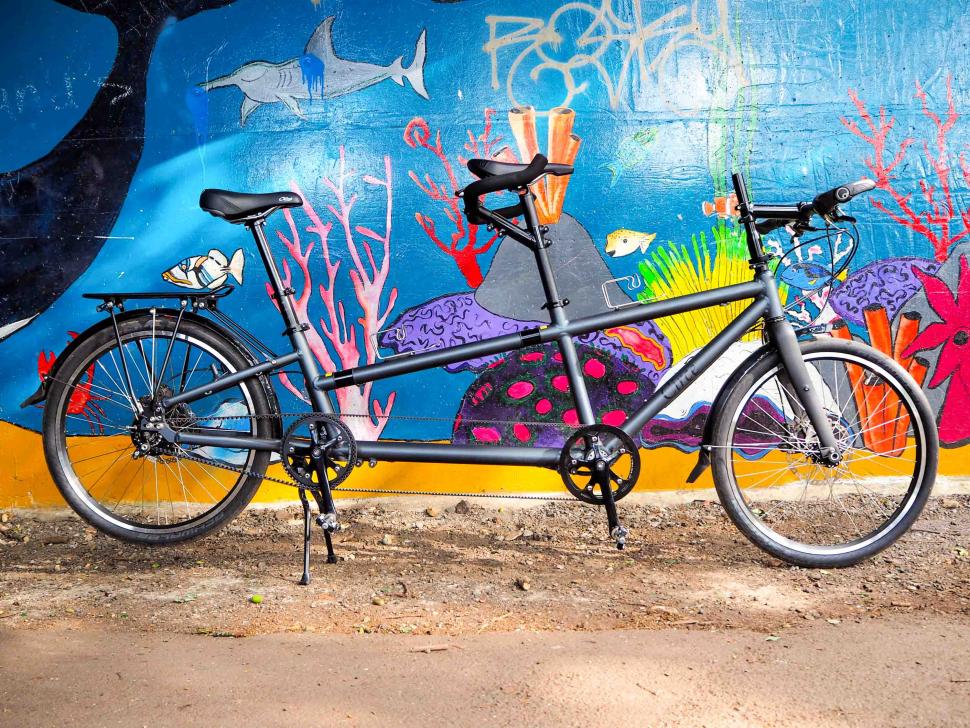
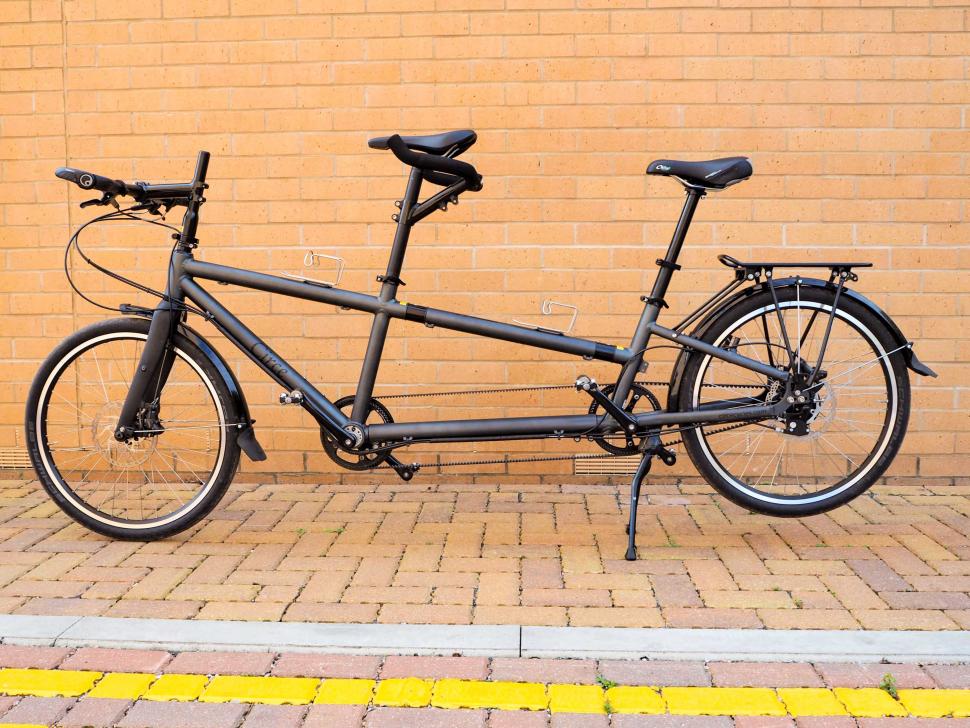


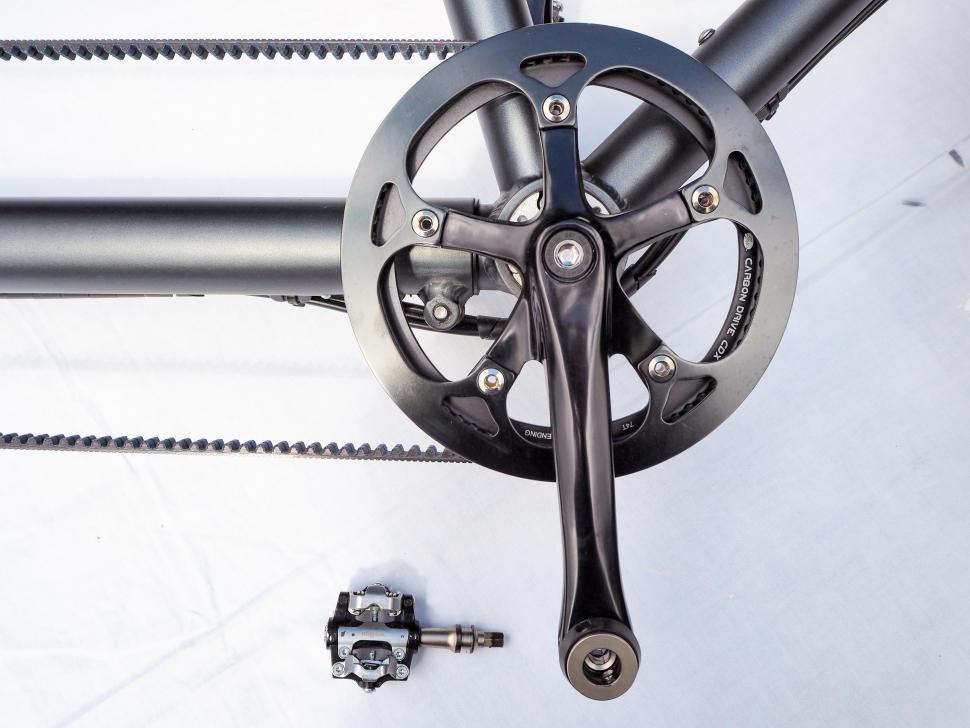

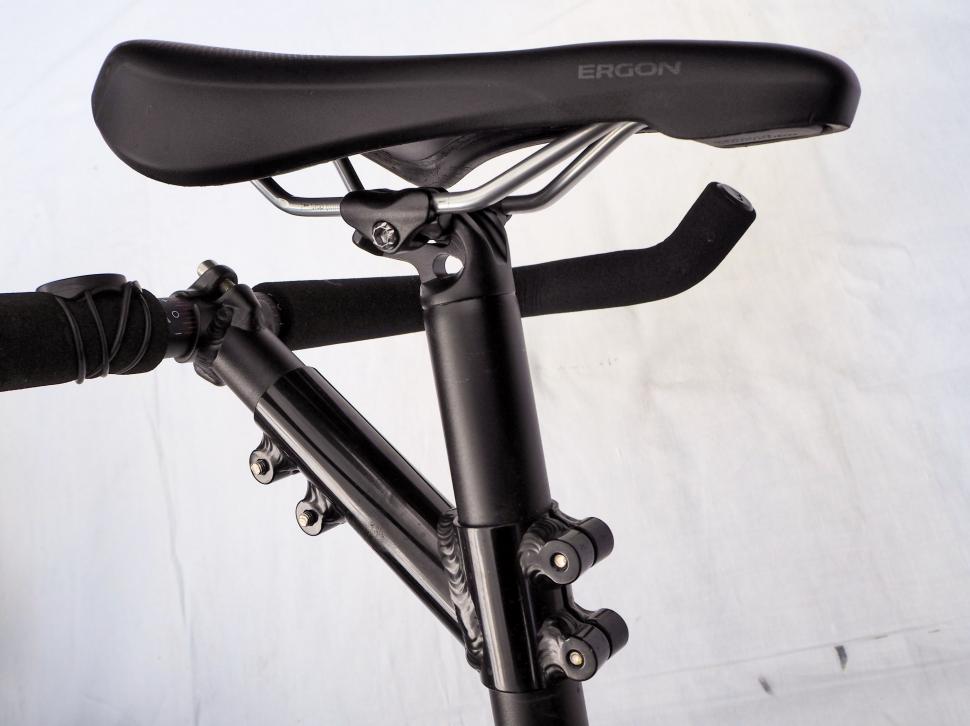
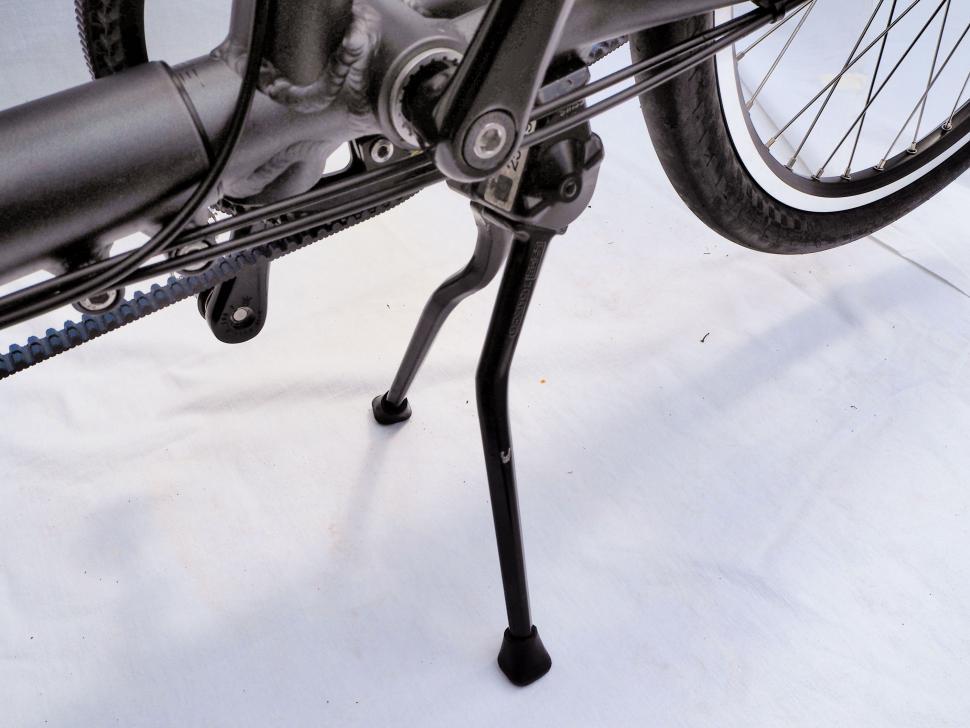


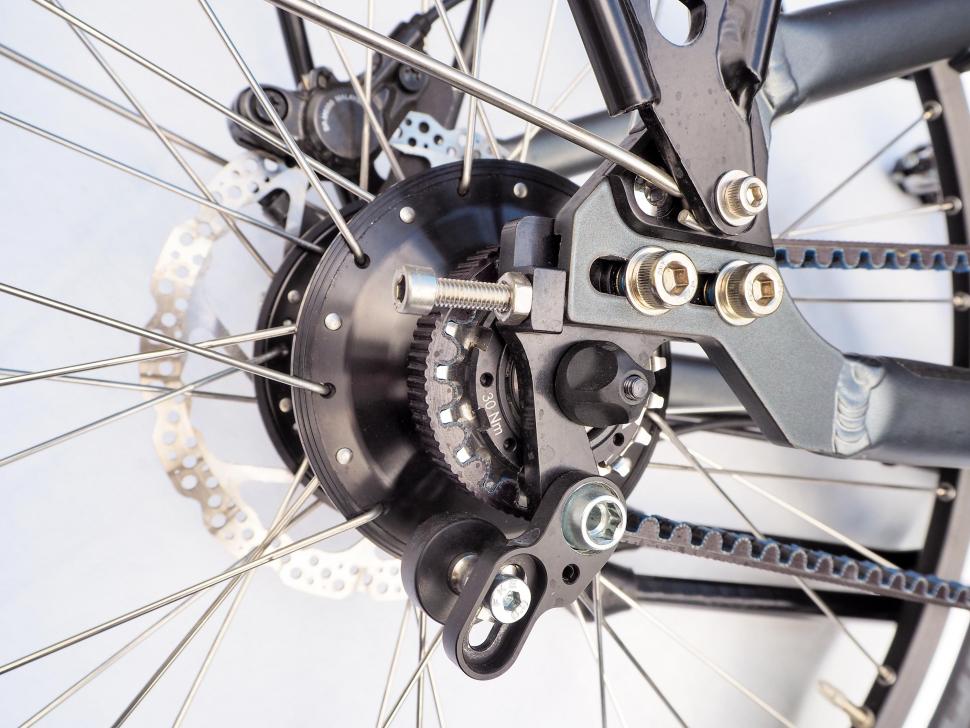

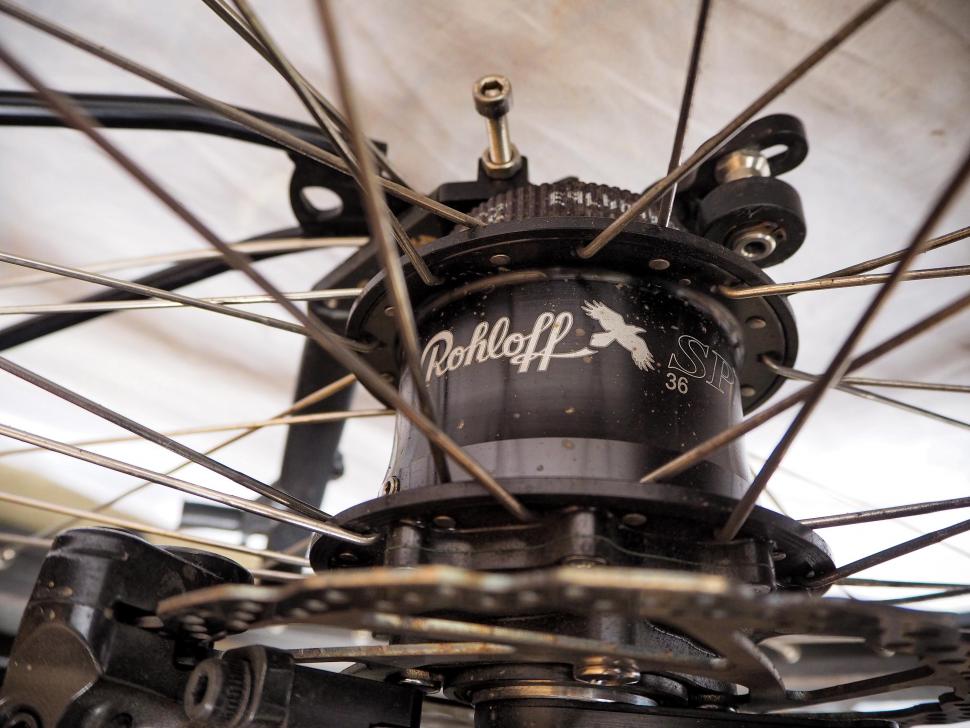
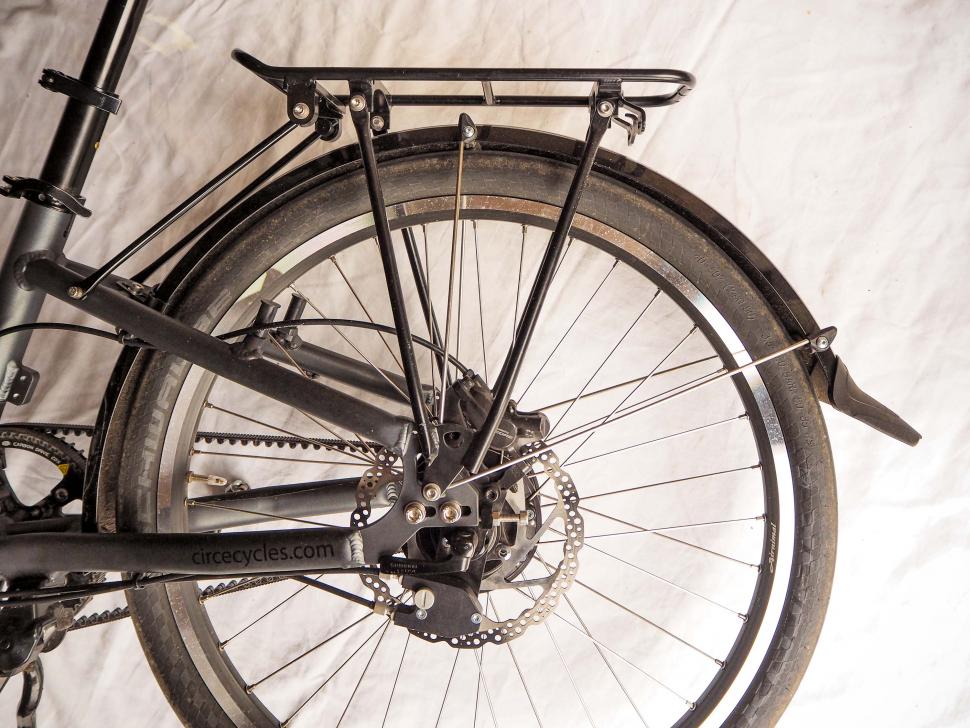

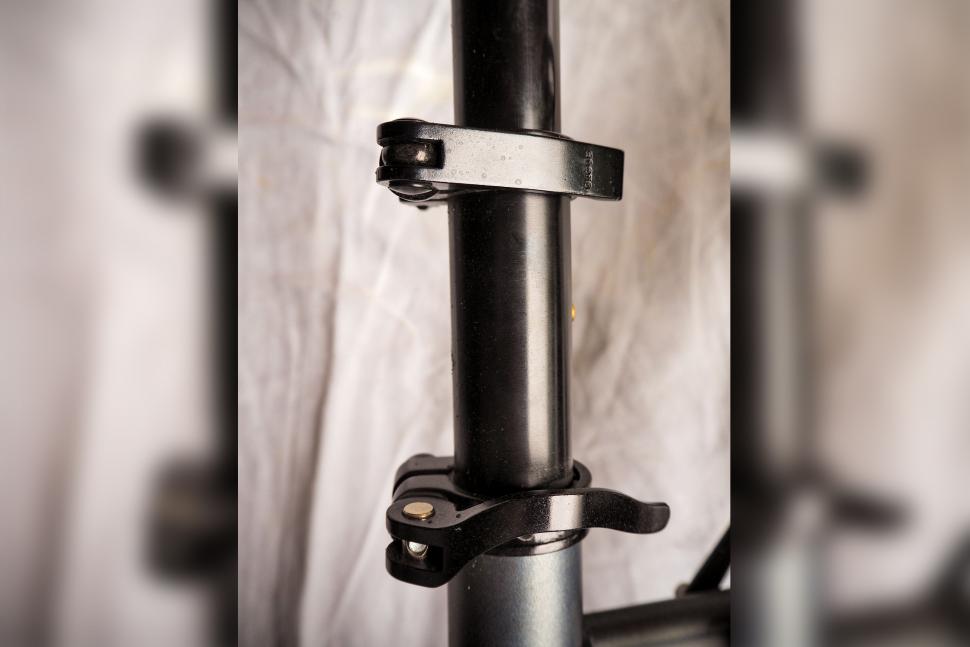
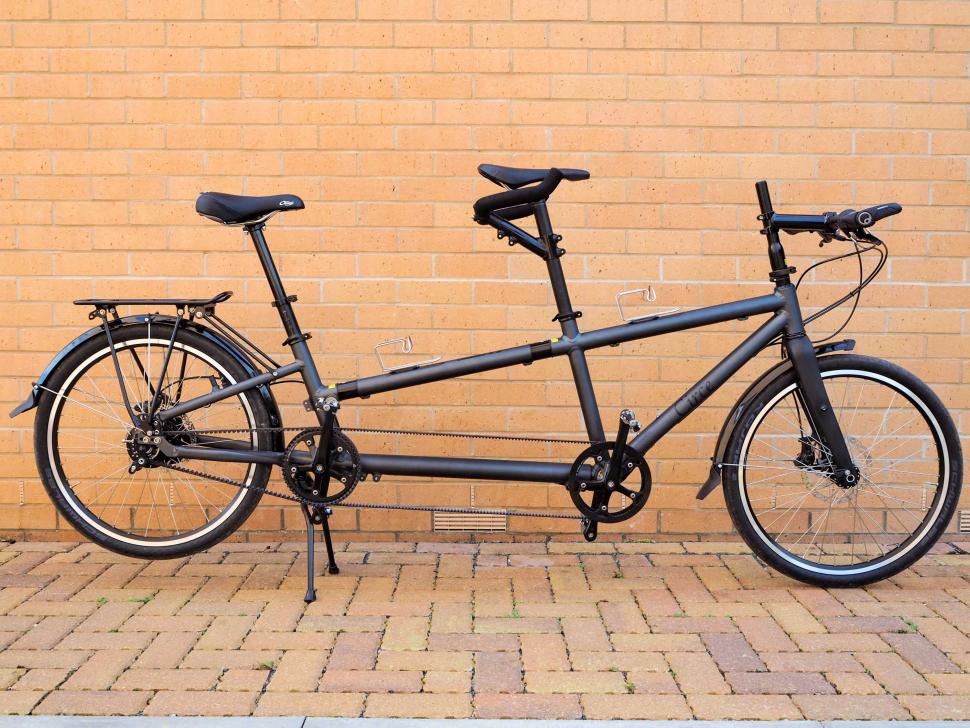

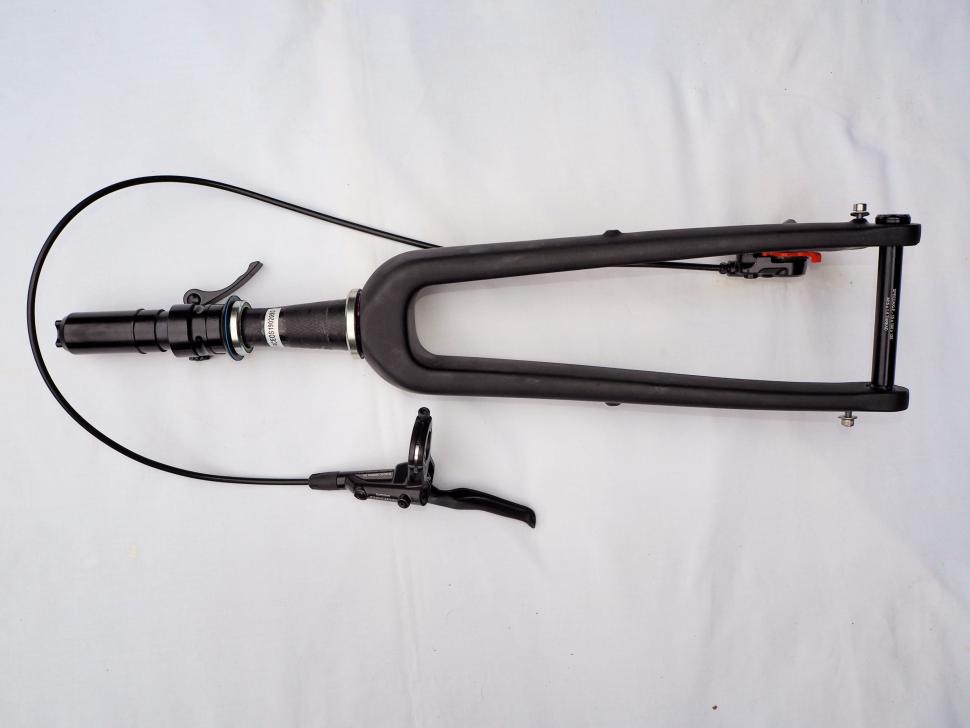

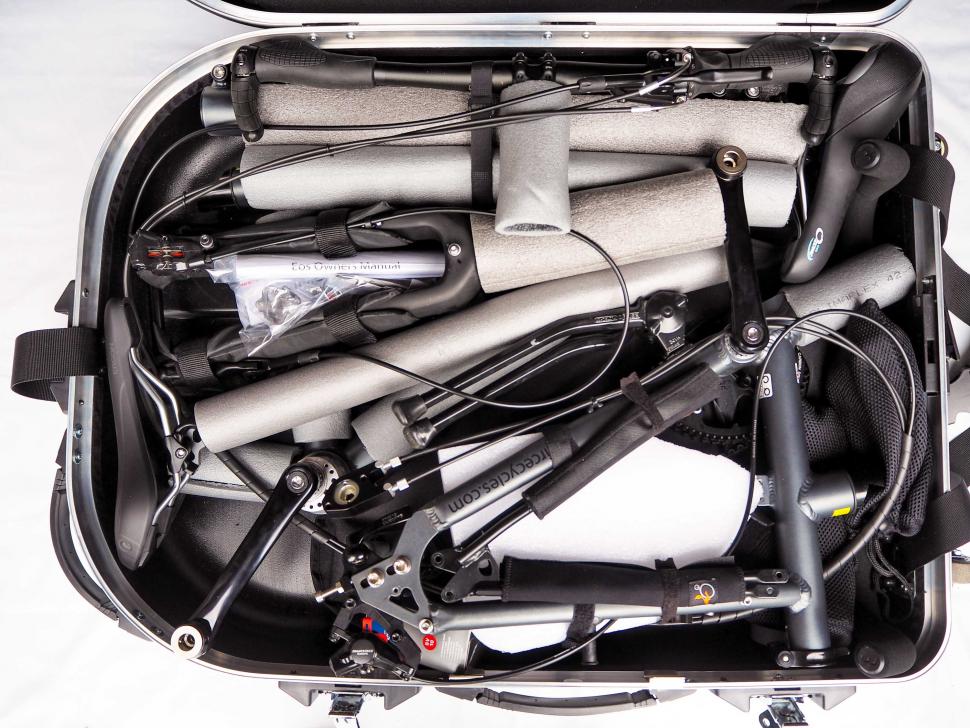

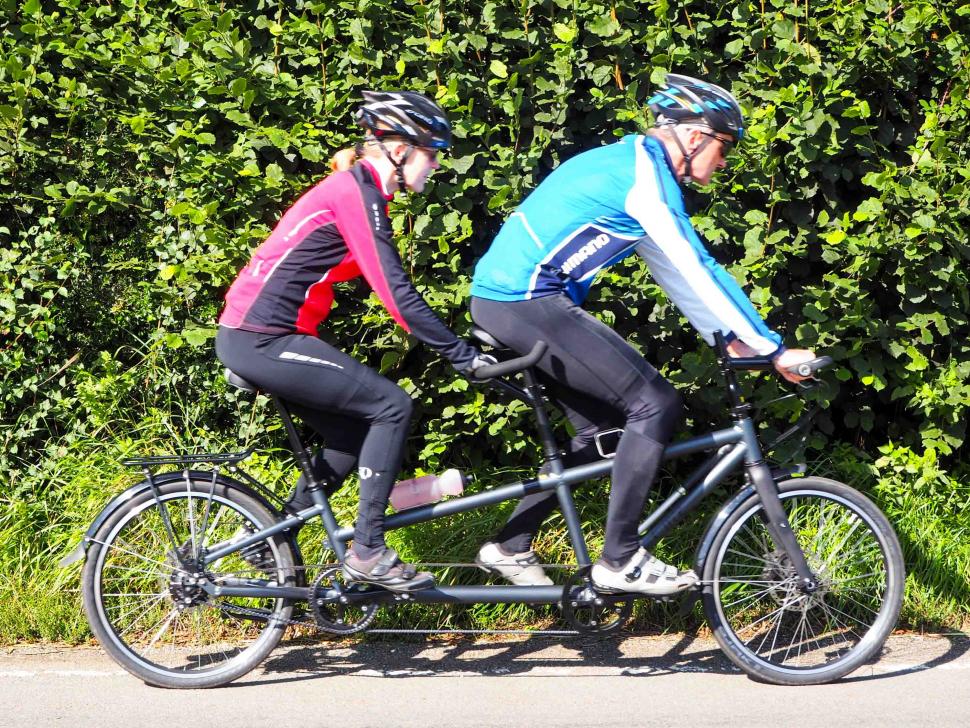

Add new comment
31 comments
Great review. Thanks! I suspect it reflects my stage in life when I spend more time poring over this review on the site than any number of carbon race bikes ;).
We've had a Helios tandem for the family for a number of years, and it's been great for the kids, both around town, on-road and even some off-road with BMX tyres. However it's a little small for my wife on the back on the ocassions when we get to ride together.
So I've been looking forward to the kids being big enough for a full size tandem in the future that my wife and I might also use touring. I'm wondering if this Eos might be the "goldilocks" - something that the kids can fit now but also a bit more suitable for two adults on longer rides?
@Richard - presumably The Eos is still quite compact so could be used around town? Also, is there any disadvantage to the smaller wheel size? The Helios has 20" wheels which I've gotten used to and been quite happy with, but I don't have many reference points as a tandem rider - my previous was a 1980s Motobecane which has 27 1/4 wheels and was rather floppy!
Thanks,
-Stuart
Circe added some extra length into the Eos’s frame, so in conjunction with the bigger wheels it won’t be as compact as a Helios – but then few tandems are. Don’t know whether you think that makes it equally suitable for use round town, but it won’t be any worse than a ‘normal’ tandem.
There is certainly a disadvantage to an unusual wheel size, in that you have less choice and availability of spare rims, tyres, and tubes. As for a smaller size, anything that you might notice on a solo bike applies equally here: typically that means quicker acceleration, but greater sensitivity to rough surfaces or potholes.
At 24”, these wheels weren’t far off our usual 26” size: you can feel a slight difference, but it’s not one that I worried about on the road; however, you will appreciate the reduction when trying to cram the machine into a case.
I can see that there is some debate over the brakes. Here is some additional information:
- The rotors were 180mm (although they do look bigger on a 24” wheel). You could go up to 200mm rotors if (for example) you were undertaking extreme descending with heavy loads; you could also add a V-brake on the back as a drag-brake
- If the only bit that worried you was the hydraulics, then you could choose something cable-operated; there is precedent, as they use Avid BB7 on the Sport model
I had Rose once build a full suspension mtb with a Rohloff hub for me. I never grew to love that bike. The Rohloff hub made so much noise I never really liked riding the bike and after only 4200km in 7 years (compared with 21000km in 8yrs on my previous mtb) I disassembled it and sold the parts and went back to a hardtail with a derailleur hub.
Shame mate, I really liked my Surly Ogre build with Rohloff, the sound was going down, but I do find it useful to know what gear I am in. Broke the frame unfortunately, and waiting for a warrenty replacement in the middle of a worldwide bike boom is a bit frustrating.
The amount of cleaning and sorting I am having to do with my derailleur geared bikes is so much than the Rohloff set up, especially now the filth has truely returned.
I really want her back.
Hope sell a Rohloff specific disk, but they do seem not to make many.
If I had been younger and faster uphill I might have been able to use higher gears and not listen to the noise of the lower ones but it is hilly where I live and I used to go down to Riva del Garda with my son quite often and I spent a lot of time in those low gears flogging up mountains. There is something else it did not mention above.
One day I arrived back in Riva del Garda and got off my bike to find the back end covered in oil. The left side plate of the Rohloff had lost, I think, 5 of the eight screws and the remaining three were all loose. That failure was another factor in going back to a derailleur though Rohloff did say it had been a bad batch of screws and not a general problem.
I don't have a problem cleaning and maintaining derailleurs but I understand that you like the advantage of low maintenance, gear range, gear indicator and so on. I hope you get a replacement frame soon. Btw I did have to look up what a Surly Ogre is. Not such a monster as my fully was.
A very in depth write up on an interesting tandem. I do however find of concern the use of hydraulic disc brakes. As I understand it their use on tandems is not to be recommended as they will not cope with the heat generated. I know from my own experience of regular tandeming that the brakes work A LOT harder than on any solo bike. I am therefore surprised that Helios have specced them? When hydraulic brake systems overheat they fail spectacularly, i.e. they go from working to doing nothing. Not something I would like to experience going downhill on a tandem!
That's a really interesting point. I think failure occurs when the discs can't dissapate the heat fast enough and so the temperature does not reach an equibirium but continues to rise to that which will cause damage to the disc or caliper. Also pads can fade out when too hot and so braking efficiency may be affected.
The question is what is the failure point of the brakes specced compared to teh likely operating range for this set up
As the mass of the tandem/rider system can be approximated to double that of an ordinary bike I think we can say that the rate of energy disapation is likewise doubled when stopping in the same distance.
In DH mountainbiking speed can peak higher than normal road riding, and is controlled more by braking than would be when say just riding downhill on the road. Subsequently braking systems are designed to a heavier spec to compensate. In additon whereas KE is proportional to mass, it is proportional to the square of velocity - you only need to increase the speed by 40% (approx) for the same uplift in KE as by doubling the mass.
I presume that Circe have specced their brakes to cope with normal tandem riding - they look like 200mm disc on the front wheel against a 24" wheel. This is afterall a flat pack tourer. It isn't going to endure the rigours of a hard ridden DH, XC, or even racing bike.
*note this was a quick stream of conciousness - there are a few assumptions coupled with GCSE physics. More than happy for folk to pick apart - I know that you will anyway
The problem with hydraulic discs on tandems, as opposed to cable operated discs is to do with the hydraulic fluid overheating. Once that happens it vaporises, i.e. it becomes a gas which, as we all remember from our school physics lessons, is compressible unlike fluids. At least this is what I have understood from various tandem makers who fit cable operated disc brakes but will not fit hydraulic disc brakes with possibly the exception of one developed by Hope specifically for tandem use
https://www.sjscycles.co.uk/brakes/hope-tech-3-v4-tandem-rear-disc-brake...
This uses four pistons and therefore the heat is being dissipated through a greater volume of brake fluid and a larger calliper.
Obviously anyone can spec hydraulic disc brakes on their tandem but it is worth bearing in mind that the amount of heat needed to be dissipated on a tandem’s braking system is huge compared to say a downhill mountain bike, where the braking although possibly quite violent is likely to be in short bursts giving everything time to cool down between applications. Braking on a tandem is very different. Having descended some very steep hills in the Dales and Lake District I know just how hard the brakes have to work (We use a cable operated 205mm disc with an alloy spider to better dissipate heat on the rear, and rim brake on the front, with an additional rim brake on the rear. With this set up on steep descents I alternate their use to allow them to cool off, to keep speed under control, and both together if I have to. A tandem, with an all up weight of 180kg or more, picks up a lot of speed very quickly on steep descent and creates a lot of kinetic energy to be converted into heat to stop it).
IANAP, but wouldn't the fluid need somewhere to expand into in order to transition to a gas? Unless it could significantly stretch the hoses, which would seem a fairly significant design failing, wouldn't heating it just have the effect of increasing the pressure within the hose?
In a word no! Once it vaporises it compresses. This isn't some sort of crusade on my part
Once it vaporises it compresses. This isn't some sort of crusade on my part  It's just a well documented fact. As Richard P points out in one of his replies Circe spec Avid BB7 cable disc brakes on the sports model. Interestingly BB7s are the only disc brakes (other than Hope) that are rated by the manufacturer as being suitable for tandem use.
It's just a well documented fact. As Richard P points out in one of his replies Circe spec Avid BB7 cable disc brakes on the sports model. Interestingly BB7s are the only disc brakes (other than Hope) that are rated by the manufacturer as being suitable for tandem use.
I'm not saying it's wrong - it's a long time since school physics. I just don't get how it can vapourise in the first place while it's constrained within the confines of the hose.
Edit: thinking about it again, I suppose the answer might be that 9x% of the fluid is being compressed back into a slightly shorter length of the house than it was previously occupying, leaving a slightly larger space for the 0.x% at the end to expand into and vapourise?
In your edit you have it. This is not a rigid system. There is flex in the lines themselves, but also in the pistons at either end. This is why brakes with air in them feel spongy.
BLEVE: https://en.wikipedia.org/wiki/Boiling_liquid_expanding_vapor_explosion
However, as mentioned, hydraulic brakes have some degree of movement so expansion would probably cause your pistons to push harder against the disc and bring you to a stop before you could cause an explosion.
A gas is compressible, but never to a smaller volume than it would occupy as a liquid. However, as it boils and expands it may create space in the system somewhere.
I know as the pads wear the pistons move further out and don't fully reset, and that I can push the pistons all the way back in when it's time to fit new pads, when the pistons are fully retracted the fluid must be going somewhere.
If the hydraulic system didn't have some flexibility the levers would need to be pulled further as the pads wear and this is not my experience.
see the following on hydraulic systems, particularly on open systems, with reference to a bladder. I can't say for certain this is present in the bike hydraulic brake systems, but I do know I do not need to add fluid as the pads wear, or remove it when I fit new pads.
https://epicbleedsolutions.com/blogs/articles/how-hydraulic-brakes-work
However note that boiling is a gradual process, as the brake fluid boils the amount of gas in the system will gradually increase and the brakes will gradually become more spongey. Boiling is likely to be an issue with prolonged braking to maintain speed on a long descent, rather than the relatively short application of coming to a full stop. So if brakes are becoming spongey, action can be taken - using other brakes/coming to dead stop and waiting/water cooling of rotor and calipers.
I found a good description of the issue on page 9 of this doc:
https://cdn.sram.com/sites/default/files/techdocs/gen.0000000004234_rev_...
I've never experienced a full loss of braking power, only a spongy feeling to the lever on a DH MTB uplift day, which I took note of and stopped to let them cool down.
It's not unlike water freezing (therefore expanding, because water is weird) inside a closed pipework - it makes the space, typically by bursting the pipes.
I would think that boiling hydraulic fluid would easily separate any unions or joints within the hydraulic system, or distend some part of it, whichever is the weakest link. It's not a design failure, it's inevitable, in fact I'd expect the design to have a deliberate point of failure somewhere that avoids the reservoir rupturing in your face. The system will be designed not to yield under the pressures generated by normal squeezing of the brake levers, so that displacement at the levers translates to displacement at the pistons. But it won't be able to contain the pressures generated by boiling the fluid. You could try boiling an unopened tin of soup if you remain unconvinced. On second thoughts, don't.
Edit - this seems to explain it well (for cars). So it might not be as dramatic as anything bursting, just the vapour pushing the fluid back up the reservoir:
https://physics.stackexchange.com/questions/344956/the-relevance-of-the-...
In the case of a hydraulic brake "pumping out" the fluid boils, pushes the piston out into the disk but the acts as a cushion between the force transmitted from the lever through the fluid.
The lever piston only has a certain amount of travel and most are open systems to provide automatic pad wear adjustment. So you end up without braking.
Just one small point, which often seems to be misunderstood. A fluid can be a gas or a liquid (or indeed a solid under some circumstances). It is anything which flows. It is common to confuse the terms fluid and liquid, which can lead to misunderstanding. Not trying to be 'clever' here, just pointing it out.
Technically correct, but I don't think we will get the entire industry to rename brake fluid as brake liquid?
It's a mixture of (almost entirely) liquid and some gas, so 'fluid' is arguably more technically correct. On the other hand, a liquid is a fluid, so 'brake fluid' is not wrong either... what fun
There's not a particular problem with hydraulic brakes on tandems, as long as they are used within the manufacturer's specs. I've always been able to tell when my hydraulic brakes were getting too hot and I've never experienced a sudden failure. Unlike rim brakes, where I've had a cable snap a couple of time or if the rim gets too hot, it can cause a tyre to burst.
I do think the low-spec Deore 2-piston calipers look a bit under-rated for the application. They would be fine on flat/undulating terrain with the big rotor. But if you are planning on some serious hills, then some beefy 4-pots with vented discs and pads would be a sensible upgrade. Plus adding a V-brake on a thumb shifter as a drag brake on that rear wheel.
Good review. I've got a Helios and it's been a great bike.
Thanks to Richard Peploe for the very informative and interesting review.
Regarding the hydraulic disc comments, it is worth noting that we build all our bikes to order and the brake set-up is something we typically address depending on a customer's usage.
In this case, Richard P did discuss his likely usage, and we deemed the Deore hydraulics appropriate.
Hope are the only manufacturer who approve a hydraulic disc brake for tandem use (there will be a very good reason for this). As you say if you're going to use hydraulic disc brakes on a tandem it is important to use a system that is designed for the job.
I suspect the only tandem specific bit about those Hope V4's is an extra long hose to reach the rear wheel.
The point is that they do supply it for tandem use and therefore consider it up to the job. What makes them better suited for tandem use isn't simply the longer hose. They use 4 pistons and therefore can dissipate more heat through the pads, the greater volume of brake fluid and the larger caliper.
Try and find a reputable tandem builder who specs their tandems with a hydraulic disc brake other than Hope. They won't for very good reasons.
Circe have commented on this thread:
"Regarding the hydraulic disc comments, it is worth noting that we build all our bikes to order and the brake set-up is something we typically address depending on a customer's usage.
In this case, Richard P did discuss his likely usage, and we deemed the Deore hydraulics appropriate."
We don't know what usage Richard P specified but we do know that he discussed this choice of brakes with Circe and approved it.
Circe are a very reputable tandem builder, so if they've deemed those brakes fit for the usage scenario they've been given, then they'll be fine.
The Hope V4's are just beefy 4-pot DH brakes, it's the sort of thing I would put on a tandem, as I like the Lakes too :). They'd be less hairy than the '80's tandem I took down the Honister pass with canti's and an Arai drum drag brake!
I just wanted to counter your original point that there's no place for hydraulics on a tandem. I think the reason most brake manufacturers don't specifiy tandem use is because it's a small market and they can't be bothered. But Hope are good at that sort of thing.
Circe fitted those brakes in discusion and agreement with Richard P. As far as I can see on their website Circe don't spec hydraulic disc brakes on any of their tandems. They spec Avid BB7 cable disc brakes which are rated for tandem use.
Where did I say there is no place for hydraulics on a tandem?
It was this bit I interpreted as that. But it doesn't matter, we've agreed that there are hydraulic brakes available which can work.
Indeed, that was my point. There are hydraulic disc brakes available that are rated for tandems but as far as I'm aware the only one is the Hope.
Pages